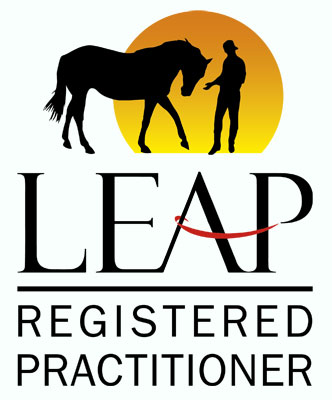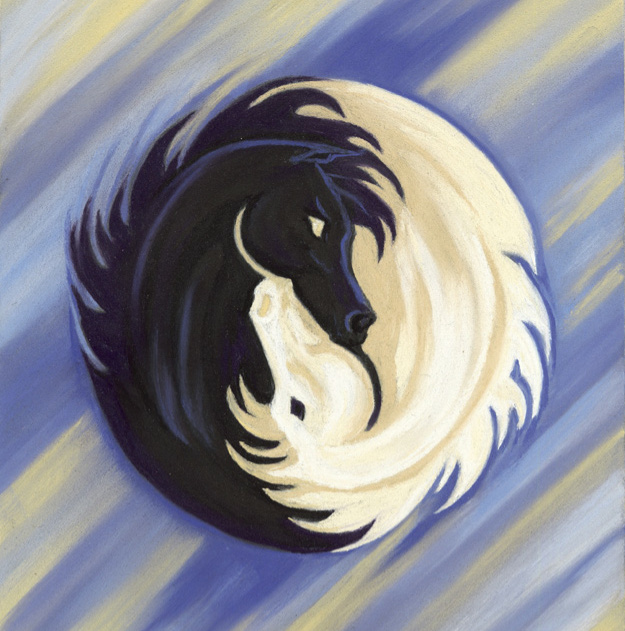
Blog
Is your Horse a Highly Sensitive Horse?
7 December 2015
Horses are a species that in the wild are preyed upon and they live at all times in family and social herds. Therefore, they are exquisitely aware of and attuned to their environment to keep safe. This means that as a species they are high sensitive animals; very much like deer, zebra, antelope, etc.
However, I am certain that, as in the case with people, within this species there is a smaller percentage that are more sensitive than other horses. In people it is estimated that 20% of the population are highly sensitive people, more on this below. This trait and percentage is commonly found in mammals.
So how can you determine that your horse may be a Highly Sensitive Horse?
Does your horse do any of the following:
1. React as if you are throwing a panther on her back when in fact you are putting on her rug, numnah, saddle, etc.?
2. Seem to always be alert to everything in their immediate environment - more so than other horses?
3. Do you have to greatly tone-down your physical behaviour on the ground and in the saddle for fear of them spooking?
4. Does your horse seem to sleep more than others in their herd?
5. Are they sometimes tricky to catch?
6. When you’re moving around them in the field or yard, do they look at you with eyes wide and ears pricked forward each time you appear from behind the barn or stable door? Much more so than their companions who are head down and chomping their hay?
7. Do they react to a trailing piece of coloured electric tape or any plastic bag flying in the wind as if it’s the devil incarnate?
8. Do they pin their ears when stabled, more so than other horses?
9. Do they react to you passing by or in to their stable with anything that rustles with a look of alarm in their eyes?
10. Do they seem to need more personal, physical space?
11. Are they very sensitive to physical touch? Do they seem to not like physical touch in certain places or at certain times?
12. Are they less likely compared to their herd members, to come over to a new person or let the new person touch them straight away?
13. Does their arousal level go from very low to very high (i.e. anxiety) in a blink of an eye?
If you answer yes to any or all of these then you probably have a Highly Sensitive Horse, or as I call it, an HSH.
The term The Highly Sensitive Person was coined by Elaine Aron, PhD who is the foremost researcher, speaker and author on the trait of high sensitivity. This is only a recent discovery but awareness of this trait in people has spread rapidly.
High sensitivity is thought to be an inherited trait with a neurological basis and because of this it cannot be “cured” with medication or simply “got over”. Highly Sensitive People (or HSPs as they are commonly referred to, can however learn to live with their trait more easily, and in many cases turn it to their advantage.
The essence of what it means to be Highly Sensitive is that you have a much more sensitive nervous system. You get overstimulated more quickly, you are more sensitive to noise, energy, smells, etc. You need more rest and down time, more sleep, a quieter working environment, and indeed usually a low-stimulation form of employment. You won’t meet many stockbrokers or Junior Doctors who are highly sensitive for example.
With regards to horses there are many similarities.
Yes some breeds are generally also more sensitive than others, for example compare a thoroughbred to a native pony. However it is also my experience that the trait of High Sensitivity runs across all breeds and so this generalisation mustn’t be taken as a given, nor let it allow you to assume that a certain breed is more sensitive, e.g. Arabians, and others not, e.g. Welsh Cobs.
I have met many cobs who turned out to be very sensitive and consequently very misunderstood by their owners. Frequently this leads to a difficult relationship as often nervous riders assume a steady cob will be suitable for them, but the horse then turns out to need a heightened level of self-awareness, calmness and confidence from their rider due to their level of sensitivity. Without this the end result is usually a more fearful and frustrated owner, who feels let down by their steady cob, and a confused and resistant horse who is simply not able to communicate to their human what they actually need to feel safe.
Why? Because a more sensitive and heightened nervous system feels like fear in horses, who are hard-wired to be sensitive and pick-up the slightest potential danger around them. Horses can’t distinguish fear, i.e. the need to flee or fight, from over- excitement, lack of confidence, too much sugar or too much stimulation from noise or visual stimulus like humans can. We can begin to learn and understand which things trigger our nervous system into overdrive, e.g. too much caffeine, or a trip to busy shopping centre and so prepare ourselves and/or avoid these stimuli.
Therefore, what our HSH needs from us is the ability to reassure them and to help them begin to calm down, no matter what has caused their over-arousal. So whether it is the flapping plastic bag or the rug you are trying to put on, the response by us must always the same. Below are suggestions for how you can do this.
However, many horse owners, breeders and trainers misunderstand some horses and quite often they get labelled as neurotic or difficult when exhibiting any of the above behaviours. The approach with horses is often to attempt to train them out of these behaviours, to de-sensitize them, and/or increasingly request that they submit to their handlers’ needs, rather than the person adapt to the needs of the horse.
In my experience gentle careful handling at all times is needed with these horses. This requires us to adapt how we deal with and approach the horse. This takes more time, more patience, more self-awareness and the willingness to listen to the horse, rather than expect them to adjust to how you normally go about your horse-handling. More on how you can actually do this a little later.
I first came across the description of a highly sensitive horse in Linda Kohanov’s fabulous book Riding Between the Worlds. In this book Kohanov talks about a hugely misunderstood and abused black Arabian stallion called Midnight Merlin, who she took on to give a second chance. What became apparent in her early dealings with Merlin was not only did she have to understand the effects on him in terms of how he had been treated by humans previously, but also Kohanov recognised, thanks to the pioneering work of Elain Aron on high sensitivity, that Merlin was most likely an HSH.
As a result of having to start from scratch with Merlin in many ways in order to simply be able to safely and effectively catch, halter and lead this feisty stallion, Kohanov had to create a whole new way of approaching, respecting and handling Merlin. Much of which entailed respecting his sensitivity, particularly in terms of approaching him and especially touching his body. Merlin was so sensitive that he demonstrated to Kohanov that in his eyes, his physical immediate personal space started about six feet from his actual body. When Kohanov experimented by performing massage moves in the air at this distance from his body, Merlin began to lower his head and lick and chew; signs of equine relaxation and release of stress.
One of my own herd members was a Morgan x Thoroughbred mare called Justin Confidence; Connie for short. From my earliest experiences of handling this mare I had to learn very quickly to do a number of things simultaneously to keep myself safe and to prevent her from running away from me, or inadvertently leaping all over me when simply leading her from field to stable.
To do anything at all with Connie, from catching her, to leading her, to taking her into a stable or arena, riding her or travelling her, I had to always be consciously attempting to keep or bring down Connie’s permanently higher level of arousal - the degree to which the nervous system is aroused.
To do this I had to ensure I was:
a) Calm.
b) Breathing deeply and ensuring I was connected to my breathing.
c) Congruent, i.e. not pretending I was okay and confident when really I was nervous, sad or angry.
d) In my body (not just in my head or dissociated) - this was the biggest indicator for Connie as the energy she picked up from me was emitted from my body directly to her, so if we were close to each other, for example if I was leading her and I was not connected fully to my body by doing the above, she would be off like a rocket, leaving me with a rope burn in my hand and a lose horse on the property.
e) Fully focused on her all the time. Not being distracted in ay way such as not thinking about something else, not chatting to a friend on the yard, and most especially not talking on my mobile phone. Any hint that I was not fully present and Connie was off.
f) Prepared to take as much time as necessary to do things with her - rushing was completely and utterly out of the question with her, (it is in fact with most horses, but as I am suggesting in this article, with HSHs it is imperative not to rush.
Rushing is simply an increased level of energy inside of you that is transmitted into the immediate vicinity that you pass through. To horses rushing feels like an intense burst of energy. It is inherently negative or incongruent energy, as it comes from a place of imbalance as your mind-body-emotions connection is absent, and involves forcing yourself, and usually those around you including horses, to move more quickly than is safely or necessary to do.
Think how children react when parents rush them due to their need to get to work, or get everything done - usually the child pushes back by reacting, getting upset or resisting this pressure. It is exactly the same with horses. And I might add, human adults. When someone tries to rush me along with their pace and agenda, I feel resistance in me which builds to annoyance if I don’t catch it and keep my own arousal level down immediately. This is why when your boss hurries you to complete something that they haven’t actually given you enough notice or time to complete properly, you feel stressed. Stress is a combination of higher arousal levels, anxiety, pressure from others and simply trying to do too much with insufficient time.
To test how this feels, get two friends and take it turns with two of you standing a few feet part, to form a gap between you of about 5-6 feet. The third person then rushes through the gap, passing you both, in a role-play of being stressed and rushing as if they’re late. Notice what the blast of energy feels like to you both. Then ask them to calm down, breath and walk calmly between you - what is the difference? Now imagine how any horse, and then a HSH might experience this energy when we rush past them in the yard, or rush into their stable, or rush up to catch them in their field.
All of this of course translates to riding too; in fact, even more so. With my mare Connie I had to be doing all of the above before mounting her and continue doing so 100% when on her back, if not, I hit the dirt, as did many others.
HSHs in my view are not for beginner or novice riders or handlers, but most especially riding as beginners and novices are themselves learning the skills of self-modulation and the art of riding and handling horses. They are therefore not in a position to proficiently be able to adjust their own arousal swiftly and soundly enough to then help the horse calm down too.
I rode and fell in love with another HSH called Cherry at a riding school where I worked and trained at as a teenager. She was very similar to Connie. Super sensitive to her personal space, noises, flapping anything, plastic, loud noises, tractors, etc. The plastic around her shavings was a daily monster coming to eat her in her view. Riding her was not for the faint hearted either. In fact only experienced riders were permitted to ride her. And to do so it was crucial to understand her needs and her higher level of arousal, otherwise, off they came. She never threw anyone off, nor did Connie. In fact the other similarity between these “difficult” horses was that they were both incredibly sweet, loving and seemed to really care about their humans. Never intentionally biting or bucking to dismount their riders. Rather they simply reacted much quicker, much bigger and with much more energy than most other horses that it was often rider or handler error that caused any accidents or falls. The errors being: not doing any of the above recommendations to ensure that the person’s own arousal level was down and that they were also paying attention to the horse’s arousal level.
Further, hacking on a loose long rein and chatting to your friend or on your phone were invitations to be dumped; literally.
One of the things I would always say to clients or assistants working with Connie was this: “Her arousal level goes from zero to 60 in a split second.” I reminded them to keep this in mind all the time around her to stay safe and be prepared without feeling anxious to calm her down; a skill in itself.
All in all Connie taught me and the clients who worked with her huge lessons in self-awareness, energy modulation and how to develop true confidence; her name couldn’t have been more apt.
If you think your horse is an HSH, I recommend reading Elaine Aron’s work on the trait of high sensitivity. Research Highly Sensitive People on the Internet too as there is a plethora of information around these days. You may also like to read my article on being a HSP here, or contact me to discuss how to start changing how you understand and handle your horse. Believe me it will enhance your relationship hugely and make your time together much safer and enjoyable too, and which horse lover doesn’t want that?
© Angela Dunning, 7 December 2015








